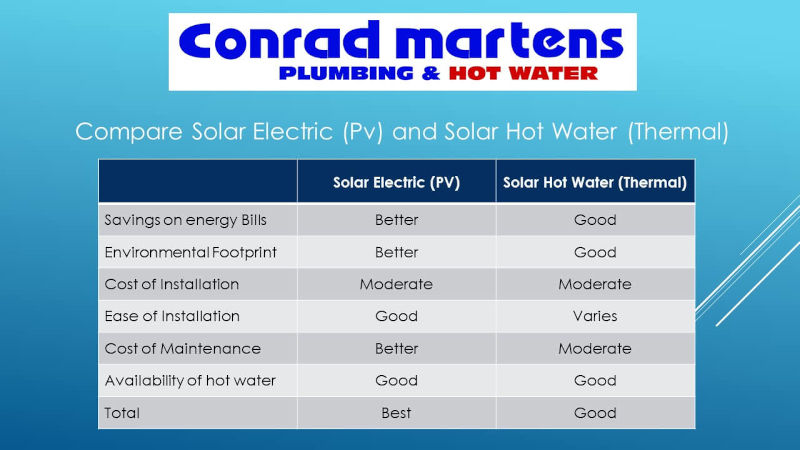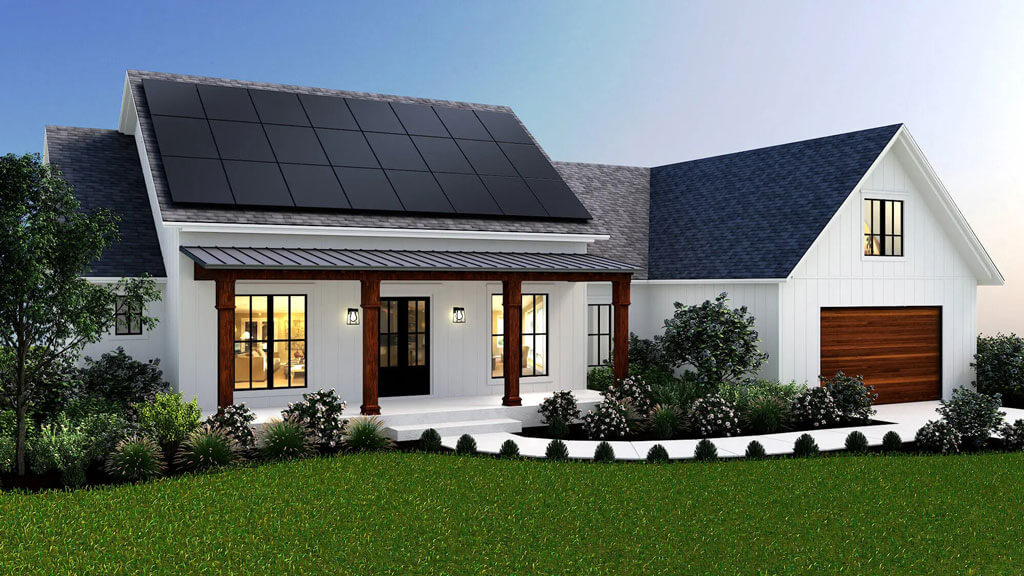
Solar Electric vs Solar Hot Water:Which Is Best for Your Home?
As the world continues to transition towards renewable energy sources, solar power has become a popular option for many households. Solar energy can be harnessed in two ways: through solar hot water systems and solar photovoltaic (PV) systems. While both systems use the sun’s energy to power homes, they function differently and have distinct advantages and disadvantages. In this blog post, we will compare solar hot water and solar PV systems to help you decide which one is right for your home. In this blog, we will explore the differences between the two systems, their energy efficiency and cost-effectiveness.
With hot water heating accounting for roughly a third of household energy consumption (Hot water systems | energy.gov.au), it’s important to consider the most economical setups to meet your needs and a fantastic place to start when making your home more energy efficient.
In recent years the evolution of solar electric technology has seen the price of panels and inverters fall significantly while the price of solar hot water heaters has risen. This leads to the question, what should I install and how do they compare?

How is Solar Hot Water and Solar Electric installed?
Confusion between types of panels is something we come across every week. Identifying whether you have solar hot water panels on the roof or solar electric panels is relatively easy. If you have more than two panels, it’s probably solar electric.
Solar electric or photovoltaic panels turn light energy into electrical current which is then converted from DC to AC and either used in the home or sent back into the grid to be used by households around your neighbourhood. Depending upon your electricity provider, the feed in tariff they give you will change but there is potential to completely cover the cost of your electricity usage.
Solar hot water panels or solar thermal panels, have water running through them and absorb the heat from the sun, transferring it to the water which is then stored in a tank for use in the home.
Installation of these systems can vary widely depending on the type of system you go with or the style of system you choose to match with your PV panels. For this comparison, we’ve chosen to focus on two selections we commonly see around Brisbane. Loline or split system solar hot water units and standard electric hot water systems run off solar electric panels on the roof.
Currently, 50% of Australian households have a standard electric hot water unit installed. If you fit into this category then the switch to more economical water heating is just a case of having solar electric (PV) panels installed by a licensed electrician.
Need assistance with your hot water system?
Please call, and we will be able to assist you today.
Call: (07) 3878 4444
We’ve got a brilliant team on the ground right now who’ll give you real, honest advice and a great price. And all our work is 100% guaranteed.
Comparing the options.
The table below is a summary comparison between the two different solar system options based on a number of considerations.

Hiline

Rheem Premier Hiline® 52H300 SS Solar Water Heater
A hiline solar hot water system has the solar collector mounted on the roof, with the storage tank also located on the roof, above or near the collector. This design allows for natural thermosyphon flow of water from the collector to the tank, where it is stored until needed. Hiline systems tend to be more efficient in terms of energy transfer, but may be more expensive to install due to the need for a sturdy roof structure to support the weight of the tank.

Rheem Premier Hiline® 52H300 SS Solar Water Heater
A hiline solar hot water system has the solar collector mounted on the roof, with the storage tank also located on the roof, above or near the collector. This design allows for natural thermosyphon flow of water from the collector to the tank, where it is stored until needed. Hiline systems tend to be more efficient in terms of energy transfer, but may be more expensive to install due to the need for a sturdy roof structure to support the weight of the tank.
Loline
A loline solar hot water system, on the other hand, has the solar collector located at ground level, with the storage tank also situated at ground level, typically within the house or a nearby shed. The water is pumped from the collector to the tank, and may require additional pumping if the tank is located some distance from the collector. Loline systems tend to be less efficient than hiline systems, but may be cheaper to install, especially if the house has a flat roof or limited roof space.

Rheem Solar Premier Loline Model 596270/2S-G

Rheem Solar Premier Loline Model 596270/2S-G
A loline solar hot water system, on the other hand, has the solar collector located at ground level, with the storage tank also situated at ground level, typically within the house or a nearby shed. The water is pumped from the collector to the tank, and may require additional pumping if the tank is located some distance from the collector. Loline systems tend to be less efficient than hiline systems, but may be cheaper to install, especially if the house has a flat roof or limited roof space.
Solar PV
Solar photovoltaic (PV) systems convert sunlight directly into electricity. This is done through the use of solar panels, which are made up of silicon cells that absorb photons from the sun’s rays and convert them into DC (direct current) electricity. The DC electricity is then sent to an inverter, which converts it into AC (alternating current) electricity that can be used to power homes and businesses. Solar PV systems can be installed on rooftops or on the ground, and can be connected to the grid or used off-grid with the help of batteries. They are a popular choice for renewable energy because they are efficient, reliable, and have no emissions or pollution. Additionally, solar PV systems have become more affordable in recent years, making them a practical option for many households and businesses.
What to consider when installing?
Depending on the model of solar hot water system you’re installing, the weight carrying ability of your roof may need to be assessed by an experienced engineer or builder to determine whether the roof trusses can handle the extra load of a solar hot water systems panels and tank. These units, known as close coupled systems can weigh upwards of 500 kg, so making sure the roof can handle this load is very important. Loline models, which split the tank and panels, locating heavy storage tanks on the ground, and only install the thermal panels on the roof require less worry when it comes to load. The panels alone aren’t hugely heavy and usually, your existing structure will handle the load fine, but it’s certainly something important to discuss with your installer.

Solar electric panels fall into a similar category and aren’t usually restricted by weight. They are significantly lighter than thermal panels which also makes installation a more simplistic task.
Due to the lightweight nature of PV panels, it’s crucial the correct mounting system is used on your roof. These panels can be affected by wind, however, proper installation will protect against this.
No matter what panels you install, location is everything! All solar panels for any use should be located as north facing as possible at roughly a 20 degree angle. In Australia, most roofs are installed at a pitch of 22 degrees which makes for a good base to lay the panels. Shade is another factor. As solar panels use the sun’s energy and heat, keeping them free of shade and making sure the panels are clean is also critical to maintaining the performance and efficiency of the panels.
Which will save me more $$?
Solar hot water and solar electric systems are both very efficient and fantastic options if you’re looking to be more environmentally friendly. However, with the installation cost of a new solar hot water unit being comparative to the cost of installing a standard electric hot water system and
installing a PV electric system on your roof, it makes it hard to go past this as the best option. Not only will the PV system generate the power required to heat your water, but it will also contribute to lowering or even completely covering the needs of your household electricity usage. Installation of a timer will ensure your hot water is heated only during the day when your PV system is generating power.
In summary, solar hot water systems and solar photovoltaic (PV) systems are both popular methods of harnessing solar energy, but they achieve this goal differently. Solar hot water systems are primarily designed to provide heated water for various applications, while solar PV systems are designed to generate electricity which can be used to power all electrical devices in the home. Our recommendation for established homes considering solar is to install a solar PV system and use this to power an electric hot water system.
More information on our solar hot water system service options is available on our website at
https://www.conradmartens.com.au/hot-water-systems-brisbane/solar-hot-water-repairs-brisbane/
Yours in keeping the good life flowing!
The Conrad Martens Team
For the best price, service and advice!




